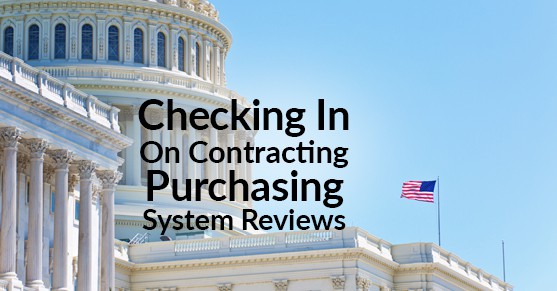The requirements for an approved Contractor Purchasing System (CPS) have become increasingly important, with many contractors being the focus of reviews from the Defense Contract Management Agency (DCMA). In light of this emphasis, GovCon365 wants to give an overview of these reviews, their regulations, how they’re conducted, and resources for contractors, including how Microsoft Dynamics can remedy many of the hardships behind CPSRs.
What is a Contracting Purchasing System Review (CPSR)?
At its base, the aim of a CPSR is twofold; first, it allows government officials to review how contractors are spending government funds, and second, confirm that they’re abiding by government policy around subcontracting. Once the review has been finalized, it presents the materials for the DCMA to evaluate purchasing systems and offer their recommendations on necessary improvements where they’re appropriate. Ultimately, an administrative contracting officer (ACO) will review an organization’s operations to determine whether a purchasing system gets approved or not.
What Regulations Govern CPSRs?
There are five regulations under DFARS and FAR governing CPSRs, each intended to evaluate and satisfy purchasing system criteria.
- FAR, Part 44.302
- Requirements for CPSR Initiation: When sales to the federal government are projected to exceed $50 million within 12 months, an ACO will give a review to determine the possibility of a full CPSR.
- FAR, Part 44.3
- Review and Consent: The ACO can inform other contractors/subcontractors of the approval status of contractors they are either in partnership with or on a job with, and prior consent is required. This helps promote transparency and accountability during the review process.
- FAR, 52.244-2
- Subcontracting Clause: In most cases, consent to work with subcontractors after approval is not required; however, there are cases under this regulation that do need consent.
- DFARS, 252.244-7001
- CPS Administration and criteria: DFARS has a 24-item list of criteria for reviewing purchasing systems, which the DCMA goes through during their review and provides the ACO with dedicated responsibilities.
- DFARS, 252.242-7005
- Finalization: As one of the primary business systems for contractors, CPSs that do not get approval are subject to financial withholdings, prominent administration fees, and potential fines. The exact details of a negative review determine the extent of withholdings and so on.
How Does the Government Conduct a Review?
Depending on the complexity and timeframe outlined by the DCMA — and the DCAA if their services are requested — there’s a six-step process for CPSRs.
- Obtain and review procedure documents/files, as well as examine price competition.
- Obtain sales data, pricing policies, pricing techniques, and other related documentation.
- Once the necessary documentation and filing have been obtained, the DCMA will conduct an entrance briefing.
- They will then begin reviewing purchase order subcontracts at the contractor’s planning, their various award levels, subcontract management, flow-down clauses, types of contracts used, procedures for subcontractor responsibilities, and any other methods and policies for their engagement with small business subcontractors.
- During this time, they will schedule daily reviews with personnel and divulge any important findings.
- Finally, the DCMA will perform an exit briefing and create the final report.
The final report will denote the severity of recommended improvements from the DCMA, which typically aim at enhancing the efficiency of the CPS. Post-review, the DCMA will continue to check in with the contractor to evaluate their performance and make sure they’re taking the corrective actions to ensure approval.
How Does a Company Prepare for a CPSR?
In another blog, we’ll be doing a more in-depth dive into the processes of preparing for a CPSR. However, for the time being, we’d like to emphasize two main points:
- Every contractor undergoing a CPSR ought to review the criteria for CPSRs outlined by DFARS (24 requirements) and the DCMA (40 requirements). A best practice would be to format these requirements into a checklist and run through them piece by piece. A thoroughly evaluated purchasing system will lend itself to approval.
- Understanding the extent of all government contracting purchasing areas is also a great way to judge your company’s current CPS status. Thankfully, to help contractors gain a better understanding of the purchasing areas, the DCMA has provided a thorough guide on purchasing areas, requirements for their maintenance, and more.
Leveraging Microsoft Dynamics to Unload the Burden?
When you evaluate your needs in light of a CPSR, there’s only one system that can provide your team with overarching support and compliance: Microsoft Dynamics 365 for Government Contractors. Below are a few ways it can give your business the upper hand when it comes to CPSRs:
- Utilize requisitions to request purchase prior to issuing a PO
- Utilize Workflow setups. This allows the purchaser to send the PO to another user who has authorization to approve the PO. Once the PO has been approved, then the purchaser can proceed with placing the order. Dynamics captures a log of steps the document has gone through. The workflow also allows for the following:
- User A can process a PO up to $5,000.
- Once the PO is over $5,000, the user must request approval from the user (User B) authorized to allow the purchase over $5,000.
- If User B is unavailable then a delegate or substitute can authorize the PO
- Customize report layout to accommodate Terms & Conditions
- Trickle-down FAR clauses
Hopefully, this article has helped shine some light on CPSRs, the regulations/criteria that guide the process, and the best software you can use when dealing with one. In our next blog on CPSR, we’ll be covering ten essential steps to prepare for a purchasing system review and the best ways to ensure approval during the first evaluation.
For more information on federal regulations for government contractors, contractor compliance, and all things government contracting, feel free to reach out to us here or via the comments below.

